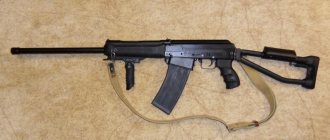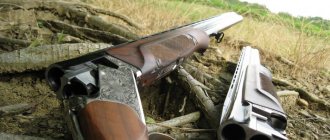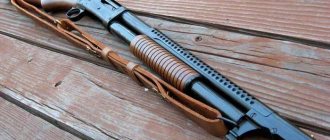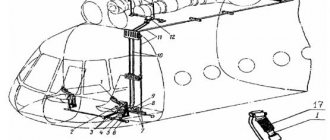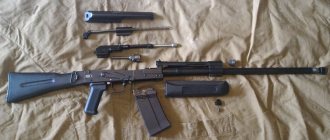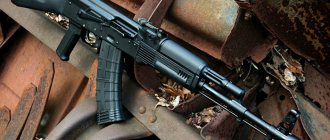Saiga-410 is a self-loading smoothbore carbine, created on the basis of the Kalashnikov assault rifle, produced by Izhevsk Machine-Building Plant JSC, part of Kalashnikov Concern JSC. The Saiga-410 carbine has a barrel caliber of .410x76 mm. Available in different modifications and designs. The carbine is intended for commercial and amateur hunting of small and medium-sized animals and birds, sport shooting and self-defense. The Saiga-410 carbine is used as a service weapon by departmental and forestry guards and employees of private security companies. The Saiga-410 carbine is popular for its external resemblance to a Kalashnikov assault rifle, for its simplicity, reliability and unpretentiousness.
Story
The first carbines of the Saiga family were created by designers in the 1970s using a 5.6x39 mm rifled cartridge. The first Saiga carbines were intended for shooting migrating herds of saigas, which in Kazakhstan and other Central Asian republics caused great damage to grain crops.
When creating the carbine, the design of the Kalashnikov assault rifle was taken as a basis, to which a number of significant changes were made: the possibility of firing in bursts was removed, the carbine was equipped with a magazine for 10 rounds, and when firing steel, bullets without a steel core were used.
In the 90s of the last century, he experienced big problems with state military orders; rampant crime in the country created a demand for smooth-bore self-loading carbines for self-defense. All this was the reason for launching the production of smooth-bore versions of the Saiga carbine.
The first smoothbore version of the Saiga carbine was the Saiga-410, chambered for the .410 Magnum cartridge, which went into production in 1993. A whole group of weapons engineers from the Izhevsk Machine-Building Plant, including G.N., worked on the creation of the Saiga-410 carbine. Nikonov, V. Afonin, V. Tsypko, A. Turkin, V. Abrahamyan, L. Ponomarev and V. Simonenko.
The case length of the .410 Magnum cartridge is 76 mm (3 inches), and the caliber is 410/1000 inches, that is, 10.2 mm. The choice of such a rare caliber at that time in our country is explained by the fact that the plant’s management was primarily focused on the foreign arms market, and also by the fact that the .410 caliber cartridge stands apart from other smoothbore cartridges and has unique characteristics.
The cartridge provides low recoil compared to cartridges of 12, 16 and 20 hunting calibers, which allows people who do not have shooting skills to shoot weapons of this caliber: novice hunters, women, teenagers.
At the same time, the .410 caliber cartridge is intended for smooth-bore weapons, which can be purchased without 5 years of hunting experience.
In the first years after the release of the Saga-410 carbine, .410-caliber cartridges were in short supply, the domestic industry practically did not produce them, and imported cartridges were expensive. Then the production of .410-caliber cartridges was established at the Tula, Krasnozavodsk and Barnaul factories.
Nowadays, Saiga-410 is still a popular model of smoothbore weapons and is in steady demand.
You can learn more about other carbines of the Saiga family in our article: Saiga carbine
Why is a .410 caliber shotgun called a “garbine carbine” in the USA?
In the United States, .410-caliber shotguns are also called garden shotguns. The nickname given to the weapon should be taken literally. This is due to the popularity of the caliber among farmers as an effective remedy against various small pests. It is convenient to shoot flocks of starlings pecking at berries with shot. Equipped with a .410R bullet, the cartridges could easily shoot a coyote or a fox stealing animals from the yard. Also, the “garden carbine” was not bad against ungulates that climbed into farmers’ fields and vegetable gardens: wild boars or deer.
American garden carabiner
Technical characteristics of the Saiga-410 carbine
- Barrel length:
330 – 570 mm - Caliber:
.410 Magnum (.410 x 76 mm) - Bore diameter:
10.25 mm - Operating principle:
self-loading, reloading due to the removal of part of the powder gases - Magazine:
removable, single-row, box-shaped for 2, 4, 8 and 10 rounds - Length:
825 - 1080 mm, with stock folded 585 - 840 mm - Weight:
3.1 - 3.4 kg - (JSC "Kalashnikov Concern")
Design of the Saiga-410 carbine
Trunk
The Saiga-410 carbine, depending on the modification and design, can have a barrel length of 330, 351, 404 or 570 mm. There are Saiga-410 carbines, which were manufactured on special orders, with barrels 483 and 612 mm long. The Saiga-410 carbine has a barrel caliber of .410x76 mm (10.2x76 mm).
All modifications and versions of the Saiga-12 carbine have chrome-plated bores and chrome-plated chambers. Chrome plating provides a long barrel life and simplifies weapon maintenance.
Saiga-410 carbines are equipped with replaceable choke constrictions, which increase the efficiency of use and expand the possibilities of using the carbine. If desired, the owner of the carbine can install a barrel extension or a Paradox rifled attachment, which lengthens the barrel and increases the accuracy of bullet shooting.
The barrels of some modifications of the Saiga-410 carbine are equipped with removable flash suppressors or muzzle compensators.
Sights
The Saiga-410 carbine is equipped with open sights: front sight and rear sight. Some modifications and versions of the carbine are equipped with an adjustable sighting bar of 5 or 10 divisions. All modifications of the Saiga-410 carbine are equipped with a dovetail side rail, which is designed for mounting optical, collimator sights or night vision sights.
Automatic and shutter
Reloading of the Saiga-410 carbine is carried out by removing powder gases through the upper hole in the barrel wall.
The gas vent mechanism of the Saiga-410 carbine differs from the gas vent mechanism of the Kalashnikov assault rifle and the rifled versions of the Saiga family carbines.
The gas piston of the Saiga-410 carbine is a separate part from the bolt frame. The gas piston moves inside the gas chamber, pushing the bolt frame rod. Mechanical decoupling of the gas piston and bolt frame allows the shooter to be protected in the event of excessive gas pressure in the gas chamber.
Most modifications of the Saiga-410 carbine do not have a gas regulator, but there are carbines that are equipped with a gas regulator for two fixed positions. The gas regulator is also a screw plug for the gas chamber and allows you to regulate the volume of powder gases entering the gas chamber.
After the bolt frame moves away under the action of gas pressure to the required distance, the powder gases are vented into the atmosphere.
The barrel of the Saiga-410 carbine is locked by turning the bolt, while the two lugs of the bolt fit into the grooves of the receiver. The shutter is rotated by bevelling the bolt frame. The return spring is located in the longitudinal channel of the bolt frame. The bolt handle is part of the bolt frame and is located on the right.
Trigger mechanism
Saiga-410 carbines can only fire single shots, so the carbine does not have a self-timer mechanism: there is no self-timer lug on the bolt frame, there is no retarder in the trigger mechanism, the hammer, sear and safety switch have been changed.
Modifications of the Saiga-410 carbine with folding stocks are equipped with a mechanism for blocking the possibility of firing a shot with the stock folded.
Butt and forearm
Various modifications of the Saiga-410 carbine can have butts and forends made of a variety of materials and have different designs. The Saiga-410 carbine can be equipped with a plastic or wooden hunting butt and fore-end.
The Saiga-410S carbines are equipped with a folding plastic stock, a pistol grip and a hunting-type forend.
Saiga-410K carbines are equipped with a folding plastic or metal frame stock and a plywood or plastic forend.
Shop
The Saiga-410 carbine is equipped with a removable box magazine with a capacity of 2, 4, 8, 10 rounds. The basic package of the main modifications usually includes 4-round magazines. The most popular among owners of the Saiga-410 carbine are 8- and 10-round magazines.
History and design of MP-18
Despite the simplicity of the design, the history of the gun is very rich. The great-grandfather of MP-18 is a purebred American Iver Johnson Champion. Even before the revolution, this gun was produced in Russia under license, but in the 20-30s the Americans became ideological opponents, and the gun was slightly modified so as not to pay for the patent.
Iver Johnson Champion - a distant ancestor of the MP-18 (IZH-18)
The new single-barreled gun began to be called “Izhevsk-Johnson”. As it became Russified, it acquired a characteristic woody quality, a thicker trunk and poor quality of processing. The service life before the barrel began to play was almost half that of the American. However, after a while the gun was upgraded to IZH-5 and its quality was already much higher. It had a design very similar to the current MP-18, but was still locked with a top key and was trigger-operated.
After the Great Patriotic War, engineer V.A. took up the modernization of the people's single-barreled gun. Kazansky, and the updated version was called ZK. From this popular gun, a very convenient system of a lever-mounted locking key invented by Kazansky took root, which migrated almost unchanged to the IZH-17 and from it to modern guns.
Modern MP-18 shotguns have the same swing-lever locking system, but have acquired a number of modern elements:
- Chrome plating of the barrel and chamber increases the life of the gun and makes the talus more stable;
- Abundance of sighting devices. There are modifications with a rail, with a rear sight and a front sight, and it is also possible to install a fence or collimator on the receiver using a dovetail;
- An ejector with the ability to turn it off speeds up recharging;
- Polymer stock and stock for greater survivability and weight reduction;
- Opportunities for installing all kinds of additional accessories, such as gel butt pads to reduce recoil;
- Push-button non-automatic fuse for greater safety.
All these elements make the gun quite modern, and the system with an ejector and a finger release lever allows a skilled shooter to fire quickly: with good skill, an experienced hunter can manage to catch 3-4 ducks from a flying flock.
By the way, the great-grandfather of the hero of our article, Iver Johnson Champion, can still be seen on shelves in the USA, where hunting with single-barreled shotguns is very popular. Ironically, there it competes in consumer sympathy with the export version of the MP-18.
Operating principle
The principle of operation of the automation of the Saiga-410 carbine completely repeats the principle of operation of the automation of the Kalashnikov assault rifle. The only exception is the trigger mechanism, which is upgraded to fire only single shots. The Saiga carbine is reloaded automatically, using the energy of the powder gases removed from the barrel.
- When you press the trigger, the hammer is released, which, under the action of the mainspring, strikes the cartridge primer with its striker, ignites it, and a shot occurs
- During a shot, part of the powder gases, through a hole in the upper wall of the barrel, enters the gas chamber
- In the gas chamber, powder gases exert their pressure on the gas piston, which sets in motion and forces the bolt frame to move backwards
- The bolt is unlocked, the cartridge case is first released from the chamber, then the spent cartridge case is ejected to the right through the window in the receiver by a spring-loaded ejector and receiver reflector, the bolt frame compresses the return spring and cocks the hammer into the firing position, which is captured by the sear
- Under the action of the return spring, the bolt returns forward, sends a new cartridge from the magazine into the chamber, and turning around its axis locks the bore and closes the bore. The carbine is ready for the next shot.
Advantages and disadvantages
Russian-made weapons are highly valued all over the world for their simplicity and clarity of design, reliability and low cost. The “four hundredth” is no exception. Izhevsk rifles have served their owners faithfully and faithfully for many years, delighting with reliability and unpretentiousness.
However, Saiga is not without a number of disadvantages. Buyers complain about low quality parts and poor assembly. The device has a whole bunch of childhood diseases in the form of all kinds of jamming and biting caused by poor fit of assembly units.
The obvious disadvantages of the model include:
- jamming of the button that fixes the stock on models with a folding stock. The problem is solved by repeatedly pressing the button and lubricating the unit. After some time, the problem disappears on most rifles;
- unsatisfactory store fixation;
- on the new carbine the front sight is shifted to the side due to the displacement of the rack;
- The gas piston has defects in the form of cracks, chips and scratches. There are cases where the piston was inserted backwards or was missing altogether;
Much less common are more serious malfunctions in the form of a crooked barrel, an inoperative magazine, or distortions in the gas mechanism.
Note! Experienced hunters are advised to carry out partial assembly and disassembly of weapons before purchasing in order to identify low-quality specimens. If you do not understand the structure of small arms, it is better to take a specialist with the necessary experience and knowledge with you to the store. Disassembling and assembling Saiga is similar to the same operations of a Kalashnikov assault rifle.
Modifications and versions of the Saiga-410 carbine
Saiga-410
The Saiga-410 carbine is the first smooth-bore modification of Saiga produced by the plant in 1993. The Saiga-410 carbine was equipped with a plastic or wooden hunting butt and fore-end. The carbine had open sights in the form of an open front sight at the end of the gas tube and a non-adjustable rear sight. The barrel length of the Saiga-410 carbine is 570 mm, the total length is 1170 mm, the weight of the carbine is 3.4 kg.
Saiga-410S
The Saiga-410S carbine is a modification of the Saiga-410 carbine with an automatic plastic stock folding on the left side, a plastic pistol grip, a hunting-type fore-end, an open front sight at the end of the gas outlet tube and a non-adjustable rear sight. The barrel length of the Saiga-410S carbine is 570 mm, the total length is 1080 mm, the length with the butt folded is 840 mm, the weight of the carbine is 3.4 kg.
Saiga-410K
The Saiga-410K carbine is a modification of the Saiga-410 carbine with a shortened barrel and a folding butt. When the stock is folded, it is impossible to fire a shot, since the firing mechanism is blocked. Sights in the form of an open front sight at the far end of the gas tube and a non-adjustable rear sight. The barrel length of the Saiga-410K carbine is 330 mm, the total length is 840 mm, the length with the butt folded is 595 mm, the weight of the carbine is 3.3 kg. In addition to the basic modification, the Saiga-410K carbine is presented by the manufacturer in several different versions:
- Saiga-410K isp.
01 is a modification of the Saiga-410K carbine with a 404 mm long barrel, a folding plastic stock and plastic forends and a gas tube cover. Sights in the form of an automatic front sight in a muzzle at the end of the barrel and a two-position rear sight for two fixed positions: 25 and 50 meters. In appearance, this version of the carbine resembles the AK-74M assault rifle. The total length of the Saiga-410K carbine is used. 01 - 910 mm, length with the butt folded 670 mm, carbine weight 3.1 kg. - Saiga-410K isp.
02 modification of the Saiga-410K carbine with a 404 mm long barrel, a folding frame metal or plastic butt and wooden or plastic handguards and a gas tube cover. At the end of the barrel there is a muzzle brake-compensator. In appearance, this version of the carbine resembles an AK-74S assault rifle. The total length of the Saiga-410K carbine is used. 02 - 910 mm, length with the butt folded 670 mm, carbine weight 3.3 kg. - Saiga-410K isp.03
is a modification of the Saiga-410K carbine with a 351 mm long barrel, a folding plastic stock and a plastic fore-end. At the end of the barrel there is a muzzle, the front sight is mounted on the gas outlet tube. In appearance it resembles a small-sized AK of the “hundredth series”. The total length of the Saiga-410K carbine is used. 03 - 825 mm, length with folded stock 585 mm, carbine weight 3.2 kg. - Saiga-410K isp.
04 modification of the Saiga-410K carbine with a 351 mm long barrel, a folding metal frame stock and a plastic or wooden fore-end and gas tube cover. In appearance it resembles the AKS-74U. The total length of the Saiga-410K carbine is used. 03 - 825 mm, length with folded stock 585 mm, carbine weight 3.2 kg.
Disassembly, assembly and maintenance
The Saiga carbine is disassembled for cleaning, maintenance or repair. To disassemble the carabiner, follow these steps:
- Press the magazine locking latch and push the bottom of the magazine forward slightly, disconnect the magazine from the carbine
- Make sure there is no cartridge in the chamber; to do this, lower the safety catch down and move the bolt to the rearmost position
- Remove the receiver cover along with the return mechanism, to do this, press down the protrusion of the return mechanism, pull the cover up and move it backwards to separate it from the carbine, then separate the return mechanism.
- Separate the bolt frame from the carbine, to do this, move it to the rearmost position and, lifting its rear part, remove it from the receiver guides along with the bolt upwards
- Separate the bolt from the bolt frame, to do this, move it to the rearmost position and turn the bolt by the head counterclockwise so that it disengages from the groove of the bolt frame, remove the bolt from the frame channel
- If necessary, disassemble the bolt by knocking out the fixing pin.
- Separate the gas chamber plug
- Unscrew and remove the gas regulator
- Separate the gas piston
- If necessary, separate the forend by unscrewing the screw of the front swivel and removing it, then remove the forend moving forward and downward.
The carbine is assembled in the reverse order.
Tuning
Many owners of the Saiga-410 carbine are upgrading it. On sale you can find a large number of different tuning elements for Saiga-410.
- Many Saiga-410 owners install high-capacity magazines, laser designators, front sights, flash suppressors, and bipods on the carbine.
- The Saiga-410 carbine can be equipped with an optical, collimator or night sight, or even a thermal imager.
- The owner can replace the factory muzzle brake-compensator with a tuned one, which can be longer and have a more interesting appearance.
- It is possible to replace the factory handguard with a high-strength aluminum alloy forend with an integrated weaver-picatinny rail, or with a tactical forend with several weaver-picatinny rails.
- The carbine can be equipped with a telescopic buttstock with an adjustable cheek rest and a built-in recoil compensator.
Tuning options
Saiga carbines of all modifications are highly valued by fans of hunting and sport shooting for their wide range of tuning options. This fully applies to the 410 caliber. If you have the necessary funds, you can replace almost any part with it. There are various options for stocks, forends, and magazines on sale, so that each hunter, if desired, can ideally adjust the weapon to his individual needs and requirements.
Tactical kit for Saiga 410
Saiga also comes with a large number of sights, from open rifle sights to collimator sights and even powerful optics. A very useful addition is the Paradox barrel attachment, designed for firing a bullet. It increases the length of the barrel, thereby accelerating the bullet. Also, thanks to the attachment, the flight of the ammunition is stabilized, which gives additional accuracy to shooting. Passing through the “Paradox”, the bullet acquires a rotational motion, which does not allow it to deviate from the original target even when in contact with branches, grass and other small obstacles.
Advantages of the Saiga carbine
The Saiga-410 carbine has a number of advantages, thanks to which it is highly valued by its owners.
- The Saiga-410 carbine, thanks to its cartridge, fairly large weight and gas-operated operating principle, has very low recoil, which allows even women and teenagers to shoot from it comfortably.
- The Saiga-410 carbine, thanks to its design and operating principle of automation, inherited from the Kalashnikov assault rifle, is distinguished by its high reliability and unpretentiousness, the ability to work in the harshest conditions.
- The carbine is quickly and easily disassembled and assembled, repairing the carbine is not difficult, and spare parts can be purchased at any gun or hunting store or ordered online.
- The Saiga-410 carbine is well suited for use as a self-defense weapon. Thanks to the self-loading operating principle and high magazine capacity, the Saiga-410 has a high rate of fire. When defending a home, the carbine allows a less experienced shooter to fire a large number of shots in a short period of time, which will scare away intruders, forcing them to abandon their intentions.
- The carbine has an appearance similar to its ancestor - the Kalashnikov assault rifle, and with the help of tuning the owner can individualize it and adjust it to his requirements. The carbine provides great tuning opportunities; the owner can install various types of sights on it, change the stock and fore-end, and install various body kit elements.
How to load a .410 caliber cartridge
The high cost of ammunition of this caliber is aggravated by their frequent absence from the shelves of gun stores. This problem is especially noticeable in the outback, where it sometimes becomes difficult to get them. But one of the advantages of the 410-caliber cartridge is the ability to load it independently. This eliminates the listed disadvantages, allowing hunters to provide themselves with the necessary ammunition.
For this, reusable metal casings or previously shot casings made of high-quality plastic are used. The most common hunting weapon in the Russian Federation today under .410R is the Saiga carbine. It has a significant margin of safety, which allows you to equip homemade ammunition with more gunpowder than factory modifications. For example, the thickness of the Saiga barrel reaches 3–3.5 mm, while for the 16-gauge MC or Izha this figure is only 1.5–2 mm. This allows you to significantly increase the muzzle energy and the speed of the bullet when fired.
The entire equipment process consists of two stages:
- Making a bullet.
- Cartridge equipment.
Self-loading .410 caliber cartridges
To cast bullets, you can use a homemade device. It is very difficult to find bullet guns for 410 caliber on sale. At home, the easiest way is to make a simple spherical bullet from lead, tin, or their alloy. But some craftsmen manage to cast very high-quality jacketed cap bullets. When lead is used for casting, the mass of the resulting bullet is about 12 grams, while the tin bullet is about 8 grams.
When choosing a material for casting, the following properties of non-jacketed bullets should be taken into account:
- The tin bullet has a higher flight speed, slightly longer firing range and penetrating ability.
- A lead bullet is softer. Therefore, although its flight speed is lower than that of tin, it has a good stopping effect. This is due to the fact that when it hits the body of a game, it crumples even in soft tissues, increasing the area of contact and the force of impact.
410 caliber bullet gun
To load the cartridge, it is best to use slow-burning varieties of Sunar-Magnum or 410 gunpowder. For shooting without barrel attachments, you can use the faster “Falcon”. However, its use is still not recommended: as a result of using the Falcon, a sharp jump in pressure occurs, recoil increases, and the box becomes more dirty (we are talking about the Saiga carbine). “Sunar” accelerates the bullet more smoothly, the pressure in the barrel increases more slowly, which gives less recoil and also prevents damage to the cartridges.
The proportions of powder filling are as follows:
- "Sunar"-410. For winter shooting 1.4-1.5 grams, for summer - 1.3 grams.
- "Sunar-Magnum". For winter - 1.3 grams, for summer - 1.2 grams.
- "Falcon". When using green Italian-made sleeves for winter and summer - 1.3–1.4 grams each. For red cartridges, a smaller charge is recommended - no more than 1.2 grams.
Smokeless hunting powder Falcon
It is more practical and faster to load ammunition yourself using special kits sold in gun stores. Their kit includes a punch, a primer knocker, a press-fit and other necessary accessories.
Disadvantages of the Saiga carbine
With all its advantages, the Saiga-410 carbine also has a number of disadvantages:
- The Saiga-410 carbine is not suitable for hunting. First of all, the Saiga-410 is a self-defense weapon and a weapon intended for recreational shooting, and not a hunting weapon. Experienced hunters prefer to use other hunting weapons for hunting.
- A 410 caliber cartridge contains a very small amount of shot; it is almost impossible to hit a flying bird with such a cartridge.
- A bullet in a 410 caliber cartridge weighs from 6 to 7.5 grams. Due to its light weight, the bullet has little destructive power and easily changes direction of flight upon contact even with thin branches of trees and bushes.
- 410 caliber cartridges, despite the smaller amount of gunpowder and the weight of the bullet or shot in the cartridge, are no cheaper than 12, 16 or 20 caliber cartridges, and they are more difficult to find on sale.
- Most modifications of the Saiga-410 carbine, due to the peculiarities of their ergonomics, are poorly suited for shooting offhand, shooting at moving targets and shooting at long distances.
- Many carbine owners complain about poor build quality and fit of parts, especially for carbines produced in the 90s of the last century. To combat all kinds of jamming and biting, owners have to fine-tune the carabiner themselves using a file, needle files and sandpaper.
Characteristics of 410 caliber
Today, 410 cartridges are produced by many arms companies, both abroad and in Russia. There are several options for ammunition of this caliber:
- Short cartridge 410 x 50.8 mm. It was this cartridge with a two-inch sleeve that was created at the end of the 19th century and was used in civilian “snake” pistols.
- Standard Winchester cartridge 410 x 70 mm, production of which began in 1934 in New England (USA region).
- The Magnum cartridge with a three-inch sleeve is the most common today. For example, it is produced at the domestic Barnaul and Tula cartridge factories. It is this type that is used in the Saiga-410 smoothbore hunting carbine, developed and produced by the Izhevsk Kalashnikov concern.
Shot hunting cartridges .410 caliber
From the first years of the launch of ammunition into mass production, competition began between arms companies for a potential buyer. As a result, a large number of different equipment options appeared:
- classic fraction;
- caliber bullet;
- sub-caliber bullet, characterized by better speed and penetrating characteristics;
- over-caliber bullet, in diameter exceeding the diameter of the bore.
Such charges are fired using special muzzle attachments. The name of the caliber was given by the British system of measures: the diameter of the cartridge is 0.41 inches. Converted to the metric system, in millimeters this would be 10.4 mm. According to the domestic classification, it occupies an intermediate position between 36 and 37. Accordingly, from 1 pound (453 grams) 36.5 spherical bullets can be cast for the .410R cartridge.
Calibers of hunting weapons in millimeters
Despite the skepticism of some hunters about this ammunition, it has good characteristics. Among them is excellent stabilization, providing good accuracy when shooting at game. Also, .410 caliber shotguns have low recoil and are lightweight. The tables below show the characteristics of some ammunition of this caliber. Bullet cartridges:
| Name | Sport-S | Brenneke silver | 40-SW | FMJ-15 | LRN-14 |
| Bullet diameter | 10.4 mm | 10.4 mm | 10.2 mm | 10.3 mm | 10.3 mm |
| Bullet weight | 6.5 g | 7.4 g | 11.5 g | 15 g | 14 g |
| Speed, m/s | 550 | 535 | 460 | 452 | 456 |
| Dispersion from 50 m | 105 mm | 60 mm | 45-56 mm | 35 | 58 |
| Bullet type | spherical | feathered | cylinder. | cylinder. | cylinder. |
Shot cartridges:
| Name | Express 410 x 65 | Magnum 410 x 75 |
| Fraction mass | 12 g | 18 g |
| Powder mass | 0.7 g | 1.05 g |
| Speed, m/s | 368 | 377 |
Key Benefits
.410R shotguns have a number of advantages that should be considered when choosing a weapon. Among them, special mention should be made of the following:
- Light weight of weapons and ammunition.
- Low recoil, which is especially important when hunting waterfowl from a boat or when conducting long-term shooting, for example, at sports competitions. The same factor makes it possible to widely use optics on such guns: sight settings are less likely to be lost, and the device itself lasts longer.
- Since the cartridge capacity when loaded with shot is smaller, the number of wounded animals when shooting at a flock of game birds is smaller.
- Excellent bullet speed, comparable to more powerful charges.
- Good accuracy of fire when the cartridge is loaded with a bullet.
- Current legislation allows the independent production of .410R hunting ammunition. This is not considered by the criminal code as the illegal manufacture of equipment for firearms. Casting spherical bullets is not so difficult, but at the same time it can save a lot of money on purchasing factory ammunition.
Hunting with Saiga 410
To purchase a rifle, a minimum of 5 years of hunting experience is required. At the same time, you can purchase a smoothbore shotgun for .410R caliber immediately after passing the hunting minimum standards and receiving a ticket.
Main disadvantages
Like any other ammunition, this cartridge also has its weaknesses. One of the main disadvantages, according to domestic hunters, is its clearly inflated cost. It is 1.5–2 times higher than the price of 16- and 12-gauge charges with lower power. This is a feature of the domestic hunting equipment market, since in Western countries the 410 caliber is one of the most budget-friendly for its price. This nuance can discourage many hunters from purchasing such weapons, hesitating between choosing a gun with a .410R or a more powerful load.
Another disadvantage characteristic of Russian cartridges is that the quality is not very high compared to foreign analogues. The cost of high-quality imported products, due to the inevitable costs of their delivery, customs and store markups, is too high. Other nuances that affect the performance characteristics: material of manufacture, type of gunpowder used, manufacturer.
Also among the disadvantages are the low stopping power of the bullet and low efficiency when firing shot at single targets. In general, the pros and cons of domestically produced charges approximately balance each other, and each hunter independently decides which gun to give preference to.
What kind of mining is this caliber suitable for?
Weapons designed for this ammunition are most effective against small and medium-sized animals. Shot cartridges are excellent for shooting at flocking game birds. The preferred sighting range is up to 50 meters. Due to the small amount of shot, it does not provide sufficient accuracy as with larger ammunition. Therefore, effective shooting at single targets, especially fast moving ones, at long distances is ineffective. For example, shooting a snipe or a duck with shot will be difficult due to the small sheaf of shot dispersion.
Small game hunting with .410 caliber
It is possible to conduct targeted fire with bullets from much greater distances. For example, the Saiga carbine is capable of confidently hitting a target with an area comparable to a human figure from a distance of 100 meters. Such weapons show the greatest effect against small and medium-sized animals: foxes, wolves, roe deer, small wild boars. As for shooting at larger game, the stopping effect of the bullet is much lower than that of the same 12 or 16 gauge. This is due to its small weight, only 7–10 grams.
Reviews of the Saiga carbine
The Saiga-410 carbine is unique in its kind; it is difficult to find a weapon that could be compared with it in terms of technical characteristics. Owners of the Saiga carbine speak of it as a very simple, reliable and unpretentious weapon; most reviews are positive. It should be noted that the Saiga-410 carbine is primarily intended for self-defense and recreational shooting, and not for hunting. In principle, you can hunt with Saiga-410, but if you are serious about hunting, then it is better to buy yourself a weapon specifically designed for this.
Basic weapon options
The .410R cartridge is used today for several types of weapons:
- hunting and sporting rifles and smooth-bore carbines;
- pump-action shotguns, pistols and revolvers used by ordinary citizens for self-defense;
- weapons for law enforcement agencies: police, army, special forces.
Pump-action Mossberg .410
One of the most famous shotguns in the West is the Remington-870, model 1950. This is an American pump-action single-barreled shotgun, used with equal success by both the US army and police, and the civilian population for self-defense and hunting. The hunting version was equipped with a magazine for 4–5 charges.
In addition to shotguns, this caliber is used in a number of large-caliber pistols, including traumatic ones:
- "Taurus" M-4510;
- Smith & Wesson GOVERNOR;
- Big-Bore "Home Defender";
- Thunder-5 by MIL Inc.
Revolver Thunder 5 410
Saiga carbine price
The Saiga-410 carbine is produced at the Izhevsk Machine-Building Plant, part of the Kalashnikov Concern. Currently, the plant produces Saiga-410K carbines of versions 02 and 04; you can buy them in weapons and hunting stores at a price of 25 to 30 thousand rubles. You can purchase a used Saiga-410 carbine through the consignment department of a gun store or through a website with advertisements for the sale of weapons. The price of such a carbine will depend on the modification, design and condition and starts from 10 thousand rubles.
